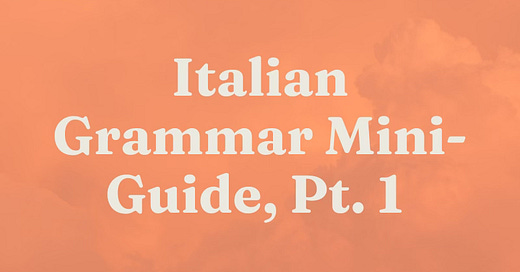Italian Grammar Mini-Guide, Pt. 1
I’m learning Mandarin Chinese right now with my daughter, and it’s been an excellent reminder of what I found useful while learning Italian.
I’m learning Mandarin Chinese right now with my daughter, and it’s been an excellent reminder of what I found useful while learning Italian.
Years ago, I wrote a mini-guide for Italian grammar to help me get a big-picture perspective on how I might express myself in a variety of ways.
Instead of keeping it in a PDF, I’ve updated it and am publishing it for you here :)
This is part I, and you can expect part II next Friday. It’s not extensive into each tense by any means, but it does give you an idea of how you would express yourself in different ways and which tense to use to do so.
Also, heads up: I don’t go over the basics like how to conjugate verbs, what it means if a verb is regular or irregular, or pronunciation here. If you want to dive deeper into each topic, I link more in-depth articles below each section.
Buono studio!
How to describe something
La mela è rossa. - The apple is red.
Notice that this sentence structure is the same as it is in English.
--> Subject (la mela) + verb (è) + adjective (rossa).
Also since “la mela” is a feminine noun and singular, the adjective (rosso) matches its ending and becomes feminine and singular with (rossa).
Lui è un uomo intelligente. - He is a smart guy.
Notice here that there is a slight shift in structure.
--> Subject (lui) + verb (è) + indefinite article (un) + noun (uomo) + adjective (intelligente)
Just like in the first example, since “uomo” is a masculine noun and singular, the adjective (intelligente) matches it and becomes masculine and singular.
Compare that to the English sentence structure where the adjective would go before the noun.
Literally they’re saying here “He is a man intelligent.”
This is common in Italian although there are adjectives that have exceptions and will go before the noun.
Just can’t wait to find out what those adjectives are? Read this article: How to Make Your Verbs, Adjectives, and Objects Agree in Italian
How to talk about possession
Keep reading with a 7-day free trial
Subscribe to Italian with Cher to keep reading this post and get 7 days of free access to the full post archives.




